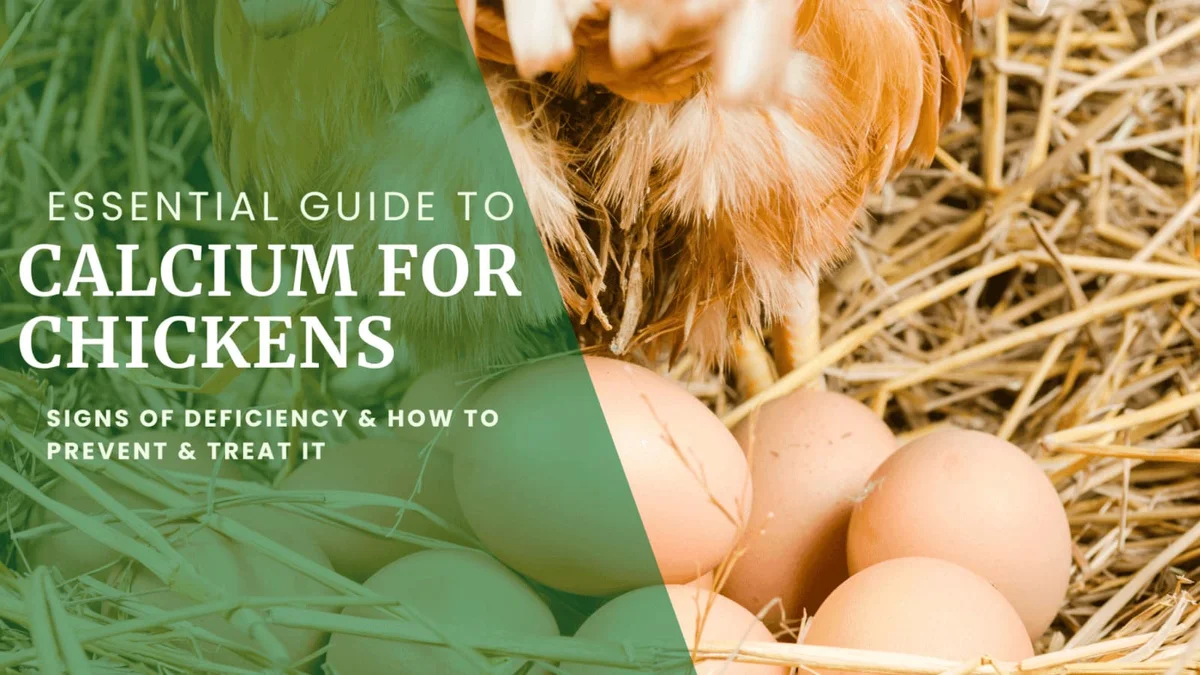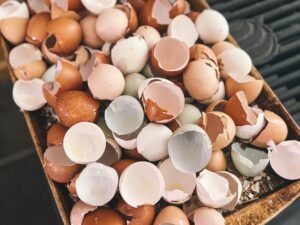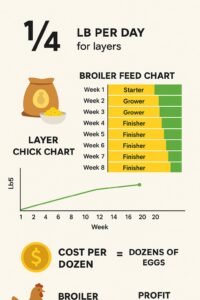If you’ve ever found a soft-shelled egg in your nesting box or watched a hen struggle to walk, you’ve witnessed the devastating effects of calcium deficiency firsthand. As someone who’s raised chickens for over a decade, I’ve learned that calcium management is one of the most critical—yet often misunderstood—aspects of chicken health.
Calcium deficiency affects up to 30% of backyard flocks, particularly during peak laying seasons. The good news? With proper knowledge and management, it’s entirely preventable. This comprehensive guide will walk you through everything you need to know about calcium for chickens, from recognizing early warning signs to implementing effective treatment strategies.
Medical Disclaimer: This guide provides general information only. Severe symptoms including paralysis, seizures, or sudden collapse require immediate veterinary attention. Never delay professional care for life-threatening conditions.
Why Calcium Matters: The Science Behind Chicken Health
Calcium is an essential mineral that powers a hen’s entire system. Without it, their body cannot function properly, leading to a cascade of health issues.
Why do Chickens Need Calcium?
Calcium isn’t just about strong eggshells—it’s fundamental to your chickens’ survival. This essential mineral plays a non-negotiable role in several biological processes.
Egg Production
The most significant drain on a hen’s calcium reserves is egg production. A single eggshell contains approximately 2 grams of calcium carbonate. For a productive hen laying 250+ eggs annually, that’s over a pound of calcium per year! If a hen’s diet is deficient, she will prioritize eggshell formation by pulling calcium directly from her own bones, leading to a rapid and dangerous depletion of her skeletal reserves.
Bone Health
Calcium is the primary building block of bones. It maintains skeletal integrity throughout a chicken’s life. Laying hens are particularly vulnerable to bone density loss, a condition known as cage layer fatigue, which results in weakened, brittle bones prone to fractures and can lead to paralysis.
Muscle Function
Calcium ions are essential for proper muscle contractions, including the rhythmic beating of the heart. Low calcium levels can cause muscle weakness, tremors, and in severe cases, seizures and paralysis. This is often the most dangerous symptom of advanced deficiency.
Blood Clotting
This mineral is a key factor in the coagulation cascade, helping a chicken’s blood clot properly after an injury. Adequate calcium levels are vital for healing from the minor scrapes and pecks that are common in active flocks.
The Calcium-Phosphorus-Vitamin D3 Relationship
Understanding calcium absorption requires grasping this critical triad. Think of it like a three-legged stool—remove one leg, and the whole system collapses.
According to Dr. Mike Petrik, a poultry veterinarian and blogger at The Chicken Vet, “The most common dietary cause of poor eggshells is a calcium deficiency, but it is not just the amount of calcium that is important—the levels of phosphorus and vitamin D3 must also be correct for calcium to be used efficiently.”
Calcium:Phosphorus Ratio
The ideal calcium to phosphorus ratio is approximately 2:1. An imbalanced ratio can severely hinder calcium absorption. Too much phosphorus, which is abundant in common treats like corn, oats, and scratch grains, will bind to calcium in the digestive tract, preventing it from being absorbed. Many chicken keepers unknowingly sabotage their calcium supplementation efforts by overfeeding these high-phosphorus foods.
Vitamin D3’s Role
Without adequate Vitamin D3, chickens simply can’t absorb calcium efficiently, regardless of how much you provide in their feed. Chickens synthesize Vitamin D3 through direct sun exposure. However, birds kept indoors or in runs with extensive cover may not get enough, necessitating a dietary supplement.
Blood pH Balance
During hot weather, chickens pant to cool themselves down. This rapid breathing, or hyperventilation, changes their blood pH, a condition called respiratory alkalosis. This pH change directly interferes with calcium absorption and deposition, explaining why summer often brings a noticeable increase in soft-helled and thin-shelled eggs. The physiological mechanism is that the drop in blood CO_2 causes a rise in blood pH, which decreases the ionized (active) calcium in the bloodstream, leading to hypocalcaemia. For more on keeping your flock safe in high temperatures, read our guide on What to Feed Chickens During a Heatwave.
How Do Calcium Requirements Change?
Not all chickens need the same amount of calcium—requirements change dramatically based on several factors. Knowing your flock’s unique needs is key to effective management.
Age Considerations
- Chicks (0-8 weeks): Need 0.9-1.2% calcium in their starter feed. Giving them high-calcium layer feed can cause irreversible kidney damage and a painful condition called tibial dyschondroplasia where cartilage fails to mature into bone. If you’re new to raising birds, check out our guide on What’s the Best Age to Start Raising Chickens?
- Growers (8-16 weeks): Requirements drop slightly to 0.8-1.0% calcium. They are building their skeletal structure, but not yet diverting resources to egg production. A lack of calcium or Vitamin D3 at this age can lead to rickets, a softening of bones that causes bowing of the legs.
- Laying Hens (18+ weeks): This is when calcium needs skyrocket to 3.5-4.0%. They require a dedicated layer feed and a free-choice supplement.
- Roosters and Non-layers: Like growers, their needs are low (0.8-1.2%) to maintain bone health without the burden of egg production.
Production Stage
- Pre-lay Pullets (14-18 weeks): This is a critical transition period. During this time, the hen’s body is preparing for egg production by building up medullary bone—a calcium reserve. Providing a high-calcium layer feed too early (before 18 weeks) can cause kidney damage, while waiting too long can lead to a deficiency right as laying begins. I introduce a gradual transition, starting with a 50/50 mix of grower and layer feed at week 16 and transitioning fully to layer feed by week 18. This gives the body time to adjust without overloading its system.
- Peak Production: This is when hens lay eggs most frequently. They are at their highest risk for deficiency and need maximum calcium support.
- Molting Hens: While not laying eggs, molting hens need increased calcium for feather regeneration, a process that requires a surprising amount of protein and minerals. Learn more about how to support your flock during this period with our guide on Chicken Molting Season.
- Retired Layers: As hens age and egg production slows, their calcium needs decrease but remain important for maintaining bone density.
Environmental Factors
- Heat Stress: High temperatures increase a hen’s calcium needs by 10-20% due to the effects of panting. When a chicken pants to cool down, it blows off carbon dioxide (CO_2) from its bloodstream. This causes a decrease in blood acidity (an increase in pH), a condition known as respiratory alkalosis. A more alkaline blood environment directly interferes with the hen’s ability to mobilize and deposit calcium from its bones, leading to soft-shelled eggs. To help your flock, you can add an electrolyte supplement to their water. A good homemade formulation is to mix 1 teaspoon of baking soda, 1 teaspoon of table salt, and 1 tablespoon of sugar into a gallon of water. In my own flock, in the summer of 2023, I noticed three of my Buff Orpingtons developing soft shells during a heatwave. After implementing cooling strategies and increasing their free-choice calcium by 20%, their shell quality improved dramatically within 72 hours.
- Cold Weather: While a hen’s diet may not change, colder weather can affect feed consumption and nutrient absorption.
- Free-Range vs. Confined: Free-ranging chickens can find natural calcium sources like small rocks, insects, and snail shells, which can help offset a marginal dietary deficiency.
How to Recognize Calcium Deficiency
The physical and behavioral signs of calcium deficiency can be easy to miss in the early stages, but knowing what to look for can prevent a serious health crisis. While this guide focuses on chickens, these symptoms are often similar across other poultry and backyard birds.
What Are the Signs of Calcium Deficiency?
Early detection can prevent serious health complications. Here’s what I watch for in my flock, progressing from subtle to severe signs.
What are the Early Warning Signs?
Eggshell Changes
The first and most obvious sign is deteriorating shell quality. You might notice:
- Thin shells: The shell feels brittle and cracks easily in your hand.
- Soft or rubber-like shells: Also known as “soft-shelled eggs” or “wind eggs,” these have a membrane but no hard shell.
- Rough, sandpaper-like texture: This indicates a lack of smooth calcium deposition.
- Misshapen or wrinkled eggs: This can be a sign of a problem in the oviduct, often related to calcium deficiency.
- Shells with visible calcium deposits: This is a paradoxical sign, indicating the hen is dumping excess, unabsorbed calcium onto the shell in an attempt to make it stronger.
Behavioral Changes
Before physical symptoms appear, you might observe a hen’s instinctive search for more calcium:
- Eating their own eggs: This is a classic sign of a desperate attempt to replenish calcium stores. For a deeper look at this behavior, check out our guide on Chickens Eating Their Own Eggs.
- Increased grit consumption: Hens will often eat more small stones or grit, as they mistake them for a source of minerals.
- Pecking at concrete, walls, or other hard surfaces: This is another clear sign of a mineral craving.
- Reduced activity levels: A hen that is weak or in pain from depleted bones will be less active.
- Decreased egg production: Laying may slow down as the body can no longer sustain the calcium demands.
What are the Progressive Symptoms?
As deficiency worsens, symptoms become more severe. This is the stage where you must act quickly.
Physical Manifestations of Hypocalcaemia
- Lethargy and weakness: The hen appears tired and reluctant to move. For a comprehensive look at why this happens, see our article on Why Is My Chicken Lethargic?.
- Difficulty standing or walking: She may be wobbly or stumble.
- Lameness, particularly in the morning: This is a key indicator, as calcium levels are at their lowest after a night of egg-laying.
- Swollen joints or “rubber legs”: The bones become soft and malformed.
- Poor feather quality: Molting may be affected, and feathers can look ragged.
- Weight loss: Despite a normal appetite, the body is unable to process nutrients efficiently.Production Issues
- Complete cessation of egg laying: The hen’s body goes on strike to prevent a fatal calcium drain.Increased egg breakage in the oviduct: Weak eggs can break internally, causing infection.Prolapsed vent from straining: A hen may strain to pass a thin-shelled or malformed egg, leading to a prolapse.
- Calcium Tetany (Acute Hypocalcaemia): This is a specific, severe condition often seen in the morning. It begins with panting, prostration, and a reluctance to move, and can rapidly progress to complete paralysis if not treated immediately.Paralysis: The inability to move legs can be a sign of severe cage layer fatigue or acute calcium tetany.Seizures or tremors: The nervous system is severely affected by the lack of calcium.Respiratory distress: The heart and respiratory muscles may be failing.Sudden death: Often, a hen will be found dead under her roost in the morning.
The key difference: While both can lead to sudden death, calcium deficiency often has pre-existing signs like poor eggshells, whereas SDS occurs without any prior symptoms in a seemingly healthy bird.
Calcium Supplementation: Methods & Sources
For the most effective calcium management, a good supplement is key. It’s important to understand the different types and how they work.
What are the Best Natural Calcium Sources?
Before reaching for commercial supplements, consider these natural calcium sources that chickens would encounter in the wild.
Leafy Greens and Vegetables
- High-Calcium Greens: Collard greens (232mg/100g), Kale (254mg/100g), Mustard greens (115mg/100g), Turnip greens (190mg/100g), and Dandelion greens (187mg/100g).
- Feeding Tips: I grow a dedicated “chicken garden” with these. Hang whole leaves at chicken height to encourage natural foraging. Chop up larger greens and mix them with a small amount of grit to improve digestion.
Insects and Protein Sources
- Black Soldier Fly Larvae (BSFL): These sustainable protein sources contain 5-8% calcium with an ideal calcium:phosphorus ratio. My chickens go crazy for them, and they are excellent for a quick calcium boost.
- Other Insect Sources: Mealworms (lower calcium, but a good treat), Cricket meal, and earthworms provide some natural calcium. For a broader list of safe kitchen scraps and treats, check out our guide on What Can Chickens Eat from Your Kitchen?.
Commercial Products: An In-Depth Look
Many brands offer high-quality calcium supplements designed for poultry. You can find these at most feed stores or online. Look for products that are specifically labeled as “Oyster Shell,” “Grit,” or “Calcium Supplement” for poultry.
What is the Best Calcium for Chickens?
For laying hens, it’s a must to give them a calcium supplement. As Dr. Jacquie Jacob, the Poultry Extension Project Coordinator at the University of Kentucky, explains, it’s essential to offer it “in a separate container, so they can take it when they need it.”
- Large Particle Calcium (65-70% of supplementation): Oyster Shells and Limestone Grit provide a slow, steady supply of calcium as they remain in the gizzard for 8-10 hours, which is essential for overnight eggshell formation. The slow absorption rate ensures calcium is available for the entire egg-laying cycle.
- Small Particle Calcium (30-35% of supplementation): Ground Limestone and Crushed Eggshells are rapidly absorbed into the bloodstream within 2-3 hours, supporting daytime metabolic needs and muscle function.
Calcium Supplement Comparison Table
| Product Type | Calcium Content | Bioavailability Rate | Cost-Effectiveness | Notes |
|---|---|---|---|---|
| Oyster Shell | ~38% | High, slow-release | Very High | Gold standard for eggshell quality. |
| Limestone Grit | ~38% | Medium, slow-release | High | Also functions as an insoluble grit. |
| Crushed Eggshells | ~40% | High, variable release | Very High (free) | Must be sterilized to prevent egg-eating. |
| Ground Limestone | ~38% | Very High, fast-release | High | Best for quick, daily absorption. |
| Black Soldier Fly Larvae | 5-8% | High | Low | Excellent treat, but not a primary calcium source. |
| Agrivite Feather Shell & Bone | ~25% | Very High | Medium | Includes Vitamin D3 and other vitamins. |
Bioavailability refers to the proportion of the substance that enters the circulation and is able to have an active effect. In poultry, this can be affected by gizzard function and metabolic rate.
Community Insights: What Are Chicken Keepers Saying?
On forums like Reddit’s r/BackYardChickens, a common question is whether store-bought eggshells are safe. The consensus is yes, as long as they are thoroughly washed, dried, and baked to sterilize them, just as we’ve outlined in our homemade supplement guide. Another frequent discussion revolves around the surprising speed at which shell quality improves—many users report seeing harder shells within just 2-3 days of providing free-choice oyster shell.
How to Treat Calcium Deficiency
When a chicken shows signs of calcium deficiency, it’s crucial to act quickly. Here’s a step-by-step guide to treating and reversing the condition.
Quick Reference: Calcium Needs, Symptoms, & Treatment
| Age/Condition | Key Symptoms | Treatment Protocol |
|---|---|---|
| Chicks (0-16 weeks) | Stunted growth, kidney damage, bowed legs | Do NOT give layer feed. Ensure starter/grower feed has appropriate calcium (\<1.2). |
| Laying Hen (Mild Deficiency) | Thin/soft shells, rough texture, increased pecking, minor lethargy | Provide free-choice oyster shell, ensure access to sunlight, reduce high-phosphorus treats. |
| Laying Hen (Moderate Deficiency) | Lameness, weakness, “rubber legs,” severe shell issues, reduced egg laying | Isolate the bird. Administer liquid calcium in water. Hand-feed supplements. |
| Laying Hen (Severe Deficiency) | Paralysis, tremors, seizures, calcium tetany, respiratory distress | Seek immediate veterinary consultation. Administer oral calcium gel. Provide supportive care. |
How to Treat Calcium Deficiency in Chickens at Home
When deficiency symptoms appear, swift action is needed to prevent permanent damage. Here is my proven treatment approach, tailored to the severity of the symptoms.
Immediate Interventions
For Mild Symptoms (thin shells, slight lethargy)
- Provide free-choice oyster shell immediately in a separate feeder.
- Add 2% ground limestone to their daily feed for one week.
- Ensure access to direct sunlight for at least 4 hours daily.
- Reduce all high-phosphorus treats to a maximum of 10% of their diet.
- Monitor for improvement within 48-72 hours.
For Moderate Symptoms (lameness, severe shell issues)
- Isolate the affected bird in a “hospital pen” for focused treatment and to prevent pecking.
- Mix a liquid calcium supplement (like Zolcal-D) in their drinking water.
- Hand-feed calcium-rich foods like plain yogurt or crushed eggshells mixed with a little water twice daily.
- Provide a vitamin D3 supplement.
For Severe Cases (paralysis, seizures)
- Immediate veterinary consultation is highly recommended. These symptoms can be life-threatening and may require professional intervention.
- An emergency calcium injection may be needed.
- Administer an oral calcium gel (1ml per pound body weight) to get calcium into her system quickly.
- Provide supportive care, including a warm, quiet space with easy access to food and water.
Recovery and Monitoring
Recovery is a process that requires patience and careful observation.
Recovery Timeline
- Days 1-3: Acute symptoms (tremors, seizures) should stabilize.
- Days 4-7: Shell quality should begin to improve, with shells feeling noticeably harder.
- Weeks 2-3: The hen may resume laying, and her physical condition should return to normal.
- Month 2+: Bone density recovery is a long-term process and may take several months. Continue to provide a high-quality, calcium-rich diet.
Long-Term Management & Special Considerations
Proper Layer Feed Selection
What to Look For
- Minimum 3.5% calcium: This is non-negotiable for laying hens.
- 16-18% protein content: A balanced diet is key.
- Added vitamin D3: Essential for absorption.
- Balanced calcium:phosphorus ratio: Read the feed label to ensure it’s correct.
- Avoid all-flock feeds for dedicated layers: These feeds have lower calcium and are not suitable for laying hens.
- For a deeper dive into chicken nutrition, read our comprehensive Guide to Feeding Your Chickens.
Feed Storage Tips
- Use within 3 months of the mill date for optimal freshness.
- Store in a cool, dry, rodent-proof container.
- Check for mold and dispose of any affected feed immediately.
Free-Choice Feeding Method
This is the most effective way to ensure hens get the right amount of calcium.
Setup Requirements
- Use a dedicated calcium feeder, separate from the grit feeder.
- Place it in a weather-protected location.
- Ensure all birds have easy access to it.
- Clean and refill it weekly.
- Position it near the nesting boxes, as hens often seek calcium before laying.
Grit vs. Calcium: Why You Need Both
Grit is a digestive aid, not a nutrient. It is composed of small, insoluble, hard stones that a chicken consumes to help grind down food in its gizzard. Without grit, a chicken’s body can’t properly digest whole grains, seeds, and other fibrous foods.
The Golden Rule: Always provide both insoluble grit and soluble calcium in separate containers, free-choice, for your laying hens. For a more detailed explanation of why both are essential, read our guide on Do Chickens Need Grit or Oyster Shells?.
Are There Special Considerations for Certain Chickens?
Can You Give Calcium to Chickens Under 16 Weeks?
⚠️ IMPORTANT WARNING: Never give high-calcium layer feed or supplements to chickens under 16 weeks of age. This is a critical rule that prevents irreversible kidney damage in growing birds. Their bodies are not yet equipped to process the high levels of calcium, which can lead to:
- Kidney stone formation: Excess calcium is excreted through the kidneys, which can cause painful stones that block the urinary tract.
- Stunted growth: The body’s focus on excreting calcium can prevent proper development.
- Premature mortality: Severe cases can be fatal.
- Permanent damage: Chronic over-supplementation can cause long-term kidney failure.
Can You Give Chickens Milk for Calcium?
Chickens lack the lactase enzymes needed to properly digest milk sugars (lactose), which can cause severe digestive upset and diarrhea. For information on a common symptom of digestive issues, check out our guide on Chicken Diarrhea.
What Are the Signs of Too Much Calcium?
While calcium deficiency is more common, excess calcium can also cause problems, including kidney damage and reduced feed consumption.
Special Cases
- Broody Hens: A broody hen is not laying eggs, so her calcium needs decrease.
- Mixed Flocks: In a flock with roosters and hens, use an all-flock feed and provide calcium separately for the hens.
Conclusion
Proper calcium management is fundamental to raising healthy, productive chickens. By understanding your flock’s changing needs, recognizing deficiency signs early, and implementing appropriate supplementation strategies, you can prevent the majority of calcium-related health issues.
The investment in proper calcium supplementation pays dividends through improved egg quality, healthier birds, and reduced veterinary costs. More importantly, it ensures your feathered friends live comfortable, productive lives.
Frequently Asked Questions
How often should I give my chickens calcium?
Calcium should be available daily for laying hens. Provide free-choice oyster shell 24/7, allowing hens to self-regulate intake. Non-laying chickens need only the calcium in their regular feed.
What does calcium deficiency in chickens look like?
Early signs include thin or soft eggshells, followed by lethargy, difficulty walking, and reduced laying. Severe cases show paralysis, tremors, and morning-specific symptoms like panting and spread wings.
How do chickens get calcium in the wild?
Wild chickens obtain calcium from diverse sources including small bones, snail shells, insects, specific plants, and natural mineral deposits. They instinctively seek calcium-rich foods when needed.
What food has calcium for chickens?
Top calcium foods include oyster shells (38% calcium), limestone (38%), crushed eggshells (40%), leafy greens like kale (254mg/100g), and black soldier fly larvae (5-8% calcium).
Can too much calcium hurt chickens?
Yes, excess calcium can cause kidney damage, reduced feed intake, and metabolic issues. Never give high-calcium layer feed to chickens under 16 weeks old, and avoid over-supplementing laying hens.
How quickly do calcium supplements work?
Shell quality typically improves within 48-72 hours of proper supplementation. Complete recovery from deficiency takes 2-3 weeks, while bone density recovery may take several months.
Should roosters eat layer feed?
No, roosters should not eat high-calcium layer feed long-term as it can cause kidney damage. In mixed flocks, use all-flock feed and provide calcium separately for hens.
Do chickens need calcium during molting?
Yes, but less than during laying. Molting hens need calcium for feather production and maintaining bone health. Reduce supplementation but maintain access to free-choice calcium.
Have you dealt with calcium deficiency in your flock? Share your experiences and questions in the comments below. For more chicken health guides and updates, subscribe to our newsletter.
Disclaimer: This guide provides general information based on experience and research. For severe health issues or specific medical concerns, always consult a qualified poultry veterinarian. This information is consistent with data provided in the Merck Veterinary Manual.

Oladepo Babatunde is the founder of ChickenStarter.com. He is a backyard chicken keeper and educator who specializes in helping beginners raise healthy flocks, particularly in warm climates. His expertise comes from years of hands-on experience building coops, treating common chicken ailments, and solving flock management issues. His own happy hens are a testament to his methods, laying 25-30 eggs weekly.



